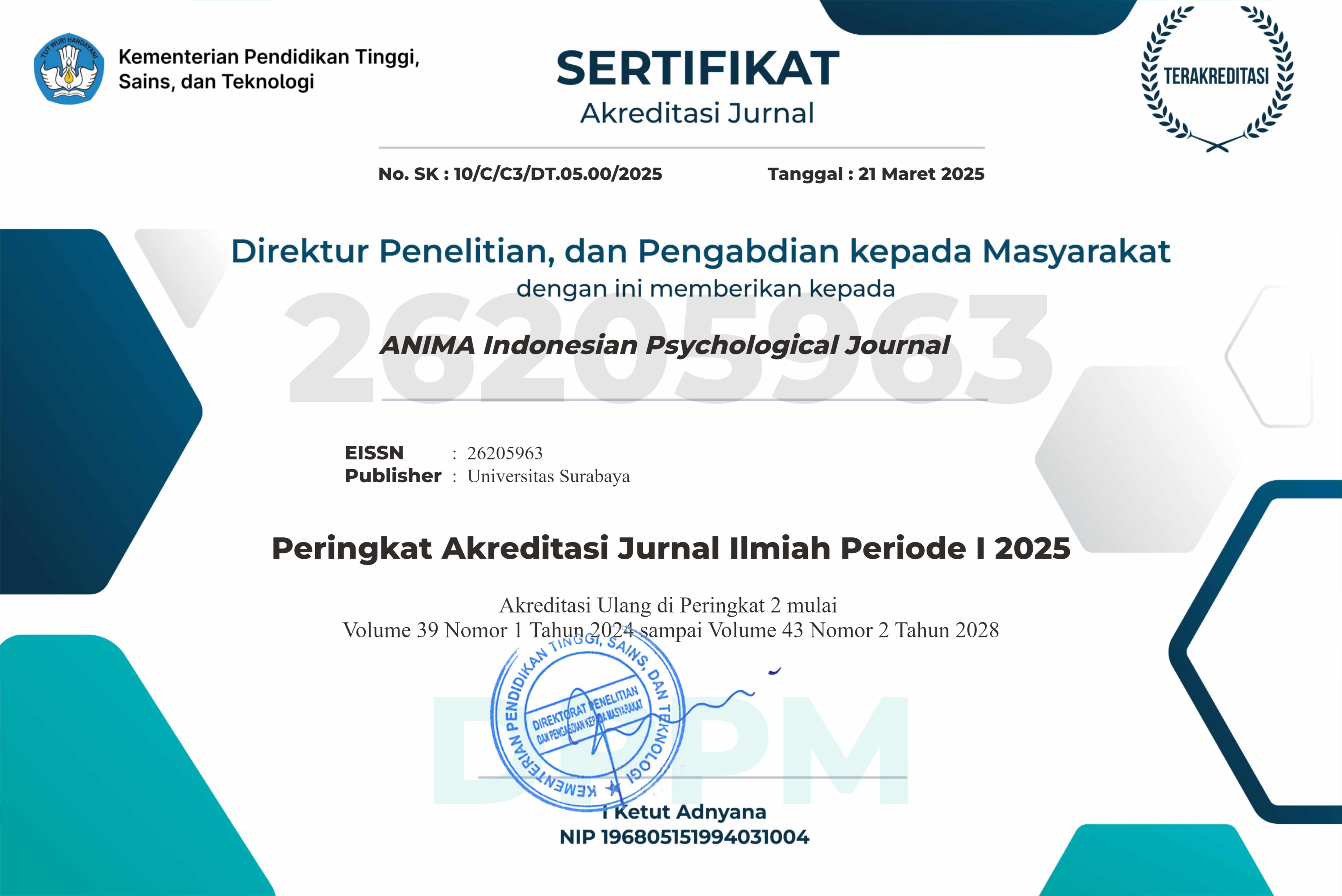The Concept of Harmony in Javanese Society
 Abstract Views:
564 times
Abstract Views:
564 times
 PDF-Full Text Downloads:
526 times
PDF-Full Text Downloads:
526 times
Abstract
Harmony is an important value that guides the behavior of Javanese. The purpose of this study is to explore the meaning of harmony for Javanese. Data were collected through in depth interviews of 12 participants, consisting of four fathers, four mothers, and four teenagers from Surakarta. Harmony is identified as maintaining connections, compatibility, resolving conflicts peacefully and empathy. Harmony consists of two categories, pseudo-harmony and essential harmony. Pseudo-harmony is maintaining relationship by burying conflicts. Essential harmony is maintaining harmony in togetherness with empathy toward each other. The implication of this study on the realm of education is discussed.
Rukun merupakan salah satu nilai penting yang memandu perilaku orang Jawa. Studi ini bertujuan mengeksplorasi makna rukun bagi orang Jawa. Data diperoleh melalui wawancara mendalam pada 12 partisipan, terdiri atas empat ayah, empat ibu, dan empat remaja yang berasal dari Surakarta. Rukun dicirikan dengan menjaga keterhubungan, menjaga keselarasan, serta mengelola konflik dan bersikap peduli. Rukun mewujud dalam dua kategori yakni rukun semu dan rukun esensial. Rukun semu berarti menjaga keterhubungan dengan memendam konflik. Rukun esensial adalah menjaga harmoni dalam kebersamaan disertai sikap saling peduli. Didiskusikan implikasi hasil penelitian pada dunia pendidikan.
Downloads
References
Bodenhausen, G. V., Macrae, C. N., & Hugenberg, K. (2003). Social cognition. In T. Millon & M. J. Lerner (Eds), Handbook of Psychology, Personality and Social Psychology, (Vol. 5, p. 257-282). New Jersey: John Wiley & Sons, Inc.
Creswell, J. W. (2007). Qualitative inquiry and research design: Choosing among five approaches. Thousand Oaks: Sage Publications. Echols, J. M., & Shadily, H. (2005). Kamus Inggris Indonesia. Jakarta: Gramedia.
Geertz, H. (1961). The Javanese family: A study of kinship and socialization. USA: The Free Press of Glenoe, Inc.
Han, A. G. (2008). Building a harmonious society and achieving individual harmony. Journal of Chinese Political Science, 13(2), 143-164. doi 10.1007/s11366-008-90-21y
Hayes, N. (2000). Doing psychological research: Gathering and analysing data. Buckingham: Open University Press.
Heckhausen, J., & Heckhausen, H. (2008). Motivation and action: Introduction and overview. In J. Heckhausen & H. Heckhausen (Eds), Motivation and action (p. 1-9). Cambridge: Cambridge University Press.
Hook, J. N., Worthington, E. L., & Utsey, S. O. (2009). Collectivism, forgiveness, and social harmony. The Counselling Psychologist, 37(6), 821-847. doi: 10.1177/0011000008326546
Hwang, K. K. (1997-8). Guanxi and mientze: Conflict resolution in Chinese society. Intercultural Communication Studies, VII:1, 17-42.
Kwan, S. Y., Bond, M. H., & Singelis, T. M. (1997). Pancultural explanation for life satisfaction: Adding relationship harmony to self-esteem. Journal of Personality and Social Psychology, 73(5), 1035-1051.
Leung, K., Koch, P. T., & Lu, L. (2002). A dualistic model of harmony and its implications for conflict management in Asia. Asia Pasific Journal of Management, 19, 201-220.
Lestari, S., Faturochman, & Adiyanti, M. G. (2013). Understanding and measuring of rukun. Paper presented at the 10th Biennial Conference of Asian Association of Social Psychology, Yogyakarta, August 21-24.
Magnis-Suseno, F. (2003).Etika Jawa: Sebuah analisa falsafi tentang kebijaksanaan hidup Jawa. Jakarta: PT Gramedia.
Oetzel, J. G., & Ting-Toomey, S. (2003). Face concerns in interpersonal conflict a cross-cultural empirical test of the face negotiation theory. Communication Research, 30(6), 599-624. doi: 10.1177/ 0093650203257841
Olson, J. M., & Maio, G. R. (2003). Attitude in social behavior. In T. Millon & M. J. Lerner (Eds). Handbook of psychology. Volume 5. Personality and social psychology. New Jersey: John Wiley and Sons.
Peng, A. C. & Tjosvold, D. (2011). Social face concerns and conflict avoidance of Chinese employees with their Western or Chinese managers. Human Relations, 64 (8), 1031-1050. doi: 10.1177/0 018726711400927
Santosa, I. B. (2010). Nasihat hidup orang Jawa. Yogyakarta: Diva Press.
Sartono, A. (2010). Pitutur luhur leluhur. Yogyakarta: Tembi Rumah Budaya.
Suratno. P. & Astiyanto, H. (2009). Gusti ora sare: 90 mutiara nilai kearifan budaya Jawa. Yogyakarta: Adiwacana.
Ting-Toomey, S., & Kurogi, A. (1998). Facework competence in intercultural conflict: An updated face-negotiation theory. International Journal Intercultural Relations, 22(2), 187-225.
Williams A., & Guendouzi, J. (2005). Constructing family relationships: Intimacy, harmony and social value in accounts of sheltered retirement community residents. Journal of Aging Studies, 19, 453–470. doi: 10.1016/j.jaging. 2004.10.002
Zhang, Q., & Andreychik, M. (2013). Relational closeness in conflict: Effects on interaction goals, emotion, and conflict styles. Journal of International Communication, 19 (1), 107-116. doi: 10.1080/13216597.2013.775069

This work is licensed under a Creative Commons Attribution-NonCommercial-ShareAlike 4.0 International License.
Articles published in ANIMA are licensed under a Creative Commons Attribution-NonCommercial-ShareAlike 4.0 International license. You are free to copy, transform, or redistribute articles for any lawful, non-commercial purpose in any medium, provided you give appropriate credit to ANIMA and the original Author(s), link to the license, indicate if changes were made, and redistribute any derivative work under the same license.
Copyright on articles is retained by the respective Author(s), without restrictions. A non-exclusive license is granted to ANIMA to publish the article and identify itself as its original publisher, along with the commercial right to include the article in a hardcopy issue for sale to libraries and individuals.
By publishing in ANIMA, Author(s) grant any third party the right to use their article to the extent provided by the Creative Commons Attribution-NonCommercial-ShareAlike 4.0 International license.




